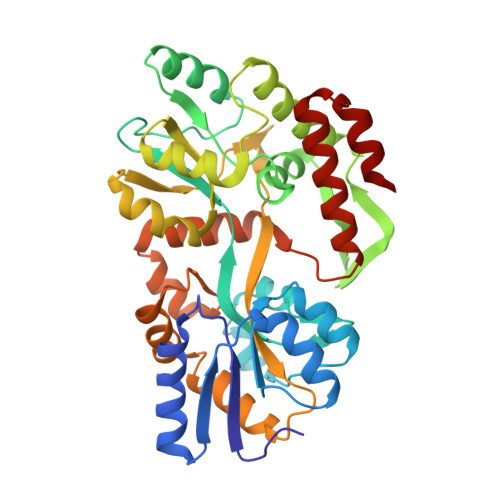Rational design of a genetically encoded NMR zinc sensor.
Zhao, Z., Zhou, M., Zemerov, S.D., Marmorstein, R., Dmochowski, I.J.(2023) Chem Sci 14: 3809-3815
- PubMed: 37035699
- DOI: https://doi.org/10.1039/d3sc00437f
- Primary Citation of Related Structures:
8ETB, 8F23 - PubMed Abstract:
Elucidating the biochemical roles of the essential metal ion, Zn 2+ , motivates detection strategies that are sensitive, selective, quantitative, and minimally invasive in living systems. Fluorescent probes have identified Zn 2+ in cells but complementary approaches employing nuclear magnetic resonance (NMR) are lacking. Recent studies of maltose binding protein (MBP) using ultrasensitive 129 Xe NMR spectroscopy identified a switchable salt bridge which causes slow xenon exchange and elicits strong hyperpolarized 129 Xe chemical exchange saturation transfer (hyper-CEST) NMR contrast. To engineer the first genetically encoded, NMR-active sensor for Zn 2+ , we converted the MBP salt bridge into a Zn 2+ binding site, while preserving the specific xenon binding cavity. The zinc sensor (ZS) at only 1 μM achieved 'turn-on' detection of Zn 2+ with pronounced hyper-CEST contrast. This made it possible to determine different Zn 2+ levels in a biological fluid via hyper-CEST. ZS was responsive to low-micromolar Zn 2+ , only modestly responsive to Cu 2+ , and nonresponsive to other biologically important metal ions, according to hyper-CEST NMR spectroscopy and isothermal titration calorimetry (ITC). Protein X-ray crystallography confirmed the identity of the bound Zn 2+ ion using anomalous scattering: Zn 2+ was coordinated with two histidine side chains and three water molecules. Penta-coordinate Zn 2+ forms a hydrogen-bond-mediated gate that controls the Xe exchange rate. Metal ion binding affinity, 129 Xe NMR chemical shift, and exchange rate are tunable parameters via protein engineering, which highlights the potential to develop proteins as selective metal ion sensors for NMR spectroscopy and imaging.
- Department of Chemistry, University of Pennsylvania Philadelphia Pennsylvania 19104-6323 USA ivandmo@sas.upenn.edu.
Organizational Affiliation:


















